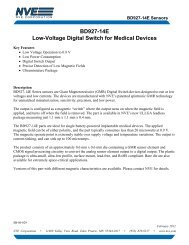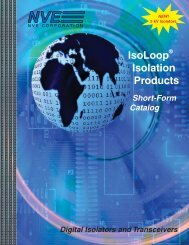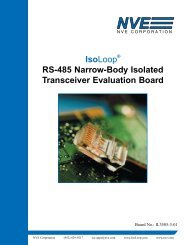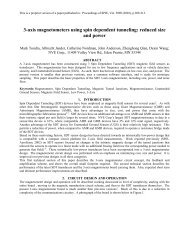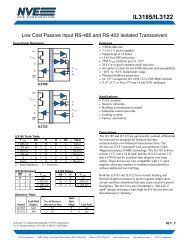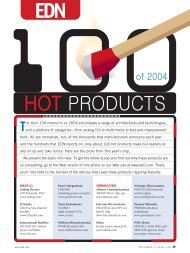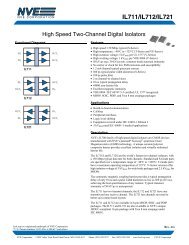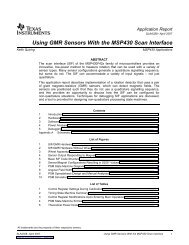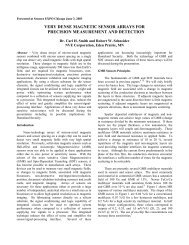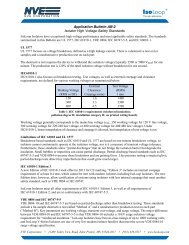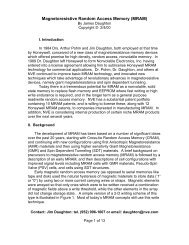GMR Sensor Catalog - NVE Corporation
GMR Sensor Catalog - NVE Corporation
GMR Sensor Catalog - NVE Corporation
You also want an ePaper? Increase the reach of your titles
YUMPU automatically turns print PDFs into web optimized ePapers that Google loves.
Introduction<br />
Introduction to <strong>NVE</strong> <strong>GMR</strong> <strong>Sensor</strong>s<br />
In 1988, scientists discovered the “Giant Magneto Resistive” effect—a large change in electrical<br />
resistance that occurs when thin, stacked layers of ferromagnetic and non-magnetic materials are<br />
exposed to a magnetic field. Since then, many companies have sought to develop practical applications<br />
for this intriguing technology. <strong>NVE</strong> <strong>Corporation</strong> has taken the lead by developing the first<br />
commercially available products making use of <strong>GMR</strong> technology, a line of magnetic field sensors that<br />
outperform traditional Hall Effect and AMR magnetic sensors.<br />
<strong>NVE</strong> introduced its first analog sensor product in 1995. Since then, our product line has grown to<br />
include several variations on analog sensors, the <strong>GMR</strong> Switch line of precision digital sensors, and<br />
our newest products, the GT <strong>Sensor</strong>s for gear tooth and encoder applications. In addition to these<br />
products, <strong>NVE</strong> offers printed circuit board assemblies for pneumatic cylinder position and currency<br />
detection applications as well as peripheral integrated circuits designed to work with our <strong>GMR</strong> sensors<br />
in a variety of applications. Finally, <strong>NVE</strong> remains committed to custom product developments for<br />
large and small customers in order to develop the best possible sensor for the customer’s application.<br />
<strong>NVE</strong> magnetic sensors have significant advantages over Hall Effect and AMR sensors as shown in the<br />
following chart. In virtually every application, <strong>NVE</strong> sensors outperform the competition—often at a<br />
significantly lower installed cost.<br />
Benefits: <strong>GMR</strong> HALL AMR<br />
Physical Size Small Small Large<br />
Signal Level Large Small Medium<br />
Sensitivity High Low High<br />
Temperature Stability High Low Medium<br />
Power Consumption Low Low High<br />
Cost Low Low High<br />
- 4 -<br />
www.nve.com phone: 952-829-9217 fax: 952-829-9189
Introduction<br />
<strong>GMR</strong> Materials Overview<br />
The heart of <strong>NVE</strong>’s sensor products are the proprietary <strong>GMR</strong> materials produced in our factory. These<br />
materials are manufactured in our on-site clean room facility and are based on nickel, iron, cobalt, and<br />
copper. Various alloys of these materials are deposited in layers as thin as 15 Angstroms (five atomic<br />
layers!), and as thick as 18 microns, in order to manufacture the <strong>GMR</strong> sensor elements used in <strong>NVE</strong>’s<br />
products.<br />
The following diagrams show how the <strong>GMR</strong> effect works in an <strong>NVE</strong> sensor using multilayer <strong>GMR</strong><br />
material. Note that the material is sensitive in the plane of the IC, rather than orthogonally to the IC, as<br />
is the case with Hall elements.<br />
- 5 -<br />
www.nve.com phone: 952-829-9217 fax: 952-829-9189
Introduction<br />
<strong>NVE</strong>’s <strong>GMR</strong> materials are noteworthy in comparison with other <strong>GMR</strong> material types in that <strong>NVE</strong>’s<br />
material cannot be damaged with the application of extremely large magnetic fields. <strong>GMR</strong> materials<br />
from other sources often rely on keeping one of the magnetic layers internally magnetized, or pinned,<br />
in a specific direction, and allowing the other layer to rotate and thus provide the <strong>GMR</strong> effect. In some<br />
of these materials, an external magnetic field as small as 200 Gauss can upset this pinned layer, thus<br />
permanently damaging the sensor element. Most of <strong>NVE</strong>’s <strong>GMR</strong> materials rely on anti-ferromagnetic<br />
coupling between the layers; as a result they are not affected by extremely large fields, and will resume<br />
normal operation after the large field is removed. <strong>NVE</strong> has recently introduced a production <strong>GMR</strong><br />
material with a pinned magnetic layer, this pinned layer uses a synthetic anti-ferromagnet for the<br />
pinning, which cannot be upset at temperatures below 300ºC. As a result, <strong>NVE</strong>’s pinned <strong>GMR</strong> material<br />
is not susceptible to upset problems.<br />
The following chart shows a typical characteristic for <strong>NVE</strong>’s standard multilayer <strong>GMR</strong> material:<br />
Electrical Resistance (Ohms)<br />
5100<br />
5000<br />
4900<br />
4800<br />
4700<br />
4600<br />
4500<br />
4400<br />
4300<br />
4200<br />
-500 -250 0 250 500<br />
Applied Magnetic Field (Gauss)<br />
Notice that the output characteristic is<br />
omnipolar, meaning that the material provides<br />
the same change in resistance for a<br />
directionally positive magnetic field as it does<br />
for a directionally negative field. This<br />
characteristic has advantages in certain<br />
applications.<br />
For example, when used on a magnetic<br />
encoder wheel, a <strong>GMR</strong> sensor using this<br />
material will provide a complete sine wave<br />
output for each pole on the encoder (rather<br />
than each pole pair, as with a Hall Effect<br />
sensor), thus doubling the resolution of the<br />
output signal.<br />
The material shown in the plot is used in most of <strong>NVE</strong>’s <strong>GMR</strong> sensor products. It provides a 98%<br />
linear output from 10% to 70% of full scale, a large <strong>GMR</strong> effect (13% to 16%), a stable temperature<br />
coefficient (0.14%/°C) and temperature tolerance (+150°C), and a large magnetic field range (0 to<br />
±300 Gauss).<br />
In addition to manufacturing this excellent <strong>GMR</strong> material, <strong>NVE</strong> is constantly developing new <strong>GMR</strong><br />
materials. New products have recently been introduced which use three new materials: one with double<br />
the magnetic sensitivity of the standard material, one with half the magnetic hysteresis, and one with a<br />
synthetic antiferromagnet pinned layer designed for use in magnetic saturation. Some of these new<br />
materials are suitable for operation to +225°C. Please see the application notes section of this catalog<br />
for a complete description of the <strong>GMR</strong> material types available in <strong>NVE</strong>’s magnetic sensors.<br />
<strong>NVE</strong> continues to lead the market in <strong>GMR</strong>-based magnetic sensors due to constant emphasis on<br />
developing new or improved <strong>GMR</strong> materials and frequent new product releases utilizing these<br />
improvements.<br />
- 6 -<br />
www.nve.com phone: 952-829-9217 fax: 952-829-9189
Introduction<br />
Basic <strong>Sensor</strong> Design<br />
<strong>NVE</strong> manufactures three basic sensor element types: magnetometers, which detect the strength of the<br />
applied magnetic field, gradiometers (or differential sensors), which detect the difference in the applied<br />
magnetic field strength at two discrete points on the sensor element, and spin valve sensors, which<br />
change in output with the angular difference between the pinned layer and the free layer of the <strong>GMR</strong><br />
material while the device is exposed to a saturating magnetic field.<br />
These three basic sensor element types are described in the sections below.<br />
Magnetometers<br />
<strong>NVE</strong>’s magnetometers are covered by our basic <strong>GMR</strong> material and sensor structure patents and have<br />
unique features designed to take advantage of the characteristics of <strong>GMR</strong> sensor materials. A<br />
photomicrograph of an <strong>NVE</strong> sensor element is shown below:<br />
5K <strong>GMR</strong> Resistors<br />
(Sensing Elements)<br />
5K <strong>GMR</strong> Resistors<br />
(Reference Elements)<br />
Flux Concentrators<br />
The size of this IC is approximately 350 microns by 1400 microns. The sensor is configured as a<br />
Wheatstone bridge. The serpentine structures in the center of the die and to the left of center under the<br />
large plated structure are 5 kΩ resistors made of <strong>GMR</strong> material.<br />
The two large plated structures shown on the die are flux concentrators. They serve two purposes.<br />
First, notice that they cover two of the resistors in the Wheatstone bridge. In this configuration the flux<br />
concentrators function as a shield for these two resistors, preventing an applied magnetic field from<br />
reaching them. Therefore, when a field is applied, the two <strong>GMR</strong> resistors in the center of the die<br />
decrease in resistance, while the two <strong>GMR</strong> resistors under the flux concentrator do not. This imbalance<br />
leads to the bridge output.<br />
- 7 -<br />
www.nve.com phone: 952-829-9217 fax: 952-829-9189
Introduction<br />
The second purpose of the flux concentrators is to vary the sensitivity of the sensor element from<br />
product to product. They work by forming a low reluctance path to the sensor elements placed between<br />
them. <strong>NVE</strong> uses a “rule of thumb” formula to calculate the effect of the flux concentrators:<br />
Field at sensor elements ≅ (Applied Field)(60%)(FC length / gap between FCs)<br />
For the sensor shown in the previous photo, the length of each flux concentrator is 400 microns, and<br />
the gap between the flux concentrators is 100 microns. Therefore, if the sensor is exposed to an applied<br />
field of 10 Gauss, the actual field at the sensor element will be about (10 Gauss)(0.6)(400 microns /<br />
100 microns), or 24 Gauss.<br />
<strong>NVE</strong> uses this technique to provide <strong>GMR</strong> sensors with varying sensitivity to the applied magnetic<br />
field. The following chart shows sensitivity ranges for some of <strong>NVE</strong>’s products. Sensitivity to the<br />
magnetic field is indicated by the slope of each line:<br />
400<br />
350<br />
300<br />
Output (mV)<br />
250<br />
200<br />
150<br />
100<br />
50<br />
AA002<br />
AA004<br />
AA005<br />
0<br />
-150 -100 -50 0 50 100 150<br />
Applied Magnetic Field (Gauss)<br />
Maximum signal output from such a sensor element is typically 350 mV at 100 Gauss with a 5V power<br />
supply. This compares to an output of 5 mV under the same conditions for a Hall sensor element, and<br />
100 mV for an AMR sensor.<br />
- 8 -<br />
www.nve.com phone: 952-829-9217 fax: 952-829-9189
Introduction<br />
Gradiometers<br />
<strong>NVE</strong>’s gradiometers, or differential sensors, rely on the field gradient across the IC to generate an<br />
output. In fact, if one of these sensors is placed in a uniform magnetic field, its output voltage will be<br />
zero. This is because all four of the bridge resistors are exposed to the same magnetic field, so they all<br />
change resistance together. There is no shielding or flux concentration on a gradiometer. A simple<br />
representation of a gradiometer is shown in the diagram below:<br />
R3<br />
R4<br />
Gradiometer<br />
(Differential <strong>Sensor</strong>)<br />
R1<br />
R2<br />
Out-<br />
R4<br />
R1<br />
Out+<br />
R2<br />
R3<br />
Because all four bridge resistors contribute to the sensor’s output, at maximum differential field <strong>NVE</strong>’s<br />
gradiometers can provide double the output signal of our magnetometer parts—approximately 700 mV<br />
with a 5V supply. In practice, the gradient fields are typically not high enough to give this maximum<br />
signal, but signal levels of 50 mV to 200 mV are common.<br />
<strong>NVE</strong>’s <strong>GMR</strong> differential sensors are typically designed with two of the bridge resistors at one end of<br />
the IC, and two at the other end. The spacing between the two sets of resistors, combined with the<br />
magnetic field gradient on the IC, will determine the output signal from the sensor element. <strong>NVE</strong><br />
offers three standard spacings for differential sensors: 0.3 mm, 0.5 mm, and 1.0 mm. If a different<br />
spacing is desired, contact <strong>NVE</strong> for development cost and schedule for a custom product.<br />
The most popular application for differential sensors is in gear tooth or magnetic encoder detection. As<br />
these structures move or spin the magnetic field near their surface is constantly varying, generating a<br />
field gradient. A differential sensor, properly placed, can detect this movement by sensing the<br />
changing field gradient and provide an output for each gear tooth or each magnetic pole (see the GT<br />
<strong>Sensor</strong> section of this catalog for a more detailed explanation). Applications for these devices include<br />
detecting the speed and position of electric motor shafts or bearings, automotive transmission gear<br />
speeds, axle shaft speed in Anti-lock Braking Systems (ABS), or linear gear-tooth position.<br />
- 9 -<br />
www.nve.com phone: 952-829-9217 fax: 952-829-9189
Introduction<br />
Spin Valve <strong>Sensor</strong>s<br />
<strong>NVE</strong>’s spin valve sensors are designed using our synthetic anti-ferromagnet pinned layer. This pinned<br />
layer is very robust, and not subject to upset or reset. The basic <strong>GMR</strong> material construction includes<br />
the pinned layer and a free layer; the free layer can be influenced by an external magnetic field in the<br />
range of 30 to 200 Gauss. The output of the sensor varies in a cosine relationship to the angle between<br />
the free layer and the pinned layer.<br />
As long as the external field strength is in the 30 to 200 Gauss range, the free layer in the <strong>GMR</strong><br />
material is saturated. It will therefore point in the same direction as the external field, while the pinned<br />
layer remains pointed in its fixed direction. The diagram below shows a vector concept of the device<br />
operation:<br />
Angle Between Pinned<br />
and Free Layers<br />
Determines Electrical<br />
Resistance of <strong>Sensor</strong><br />
Applied Magnetic Field<br />
(30 to 200 Gauss)<br />
Pinned Layer<br />
Free Layer<br />
Free Layer Aligns<br />
with the Applied<br />
Magnetic Field<br />
The percent change of resistance available with this <strong>GMR</strong> material is about 5%. The output is a cosine<br />
function over 360 degrees of angular movement by the external, saturating magnetic field.<br />
- 10 -<br />
www.nve.com phone: 952-829-9217 fax: 952-829-9189
Introduction<br />
Signal Processing<br />
Adding signal processing electronics to the basic sensor element increases the functionality of <strong>NVE</strong>’s<br />
sensors. The large output signal of the <strong>GMR</strong> sensor element means less circuitry, smaller signal errors,<br />
less drift, and better temperature stability compared to sensors where more amplification is required to<br />
create a usable output.<br />
For the <strong>GMR</strong> Switch products, <strong>NVE</strong> adds a simple comparator and output transistor circuit to create<br />
the world’s most precise digital magnetic sensor. For these products, no amplification of the sensor’s<br />
output signal is necessary. A block diagram of this circuitry is shown in the figure below:<br />
Voltage<br />
Regulator<br />
(5.8V)<br />
Current Sinking<br />
Output<br />
<strong>GMR</strong><br />
Bridge<br />
Comparator<br />
The <strong>GMR</strong> Switch holds its precise magnetic operate point over extreme variations in temperature and<br />
power supply voltage. This low cost product has revolutionized the industrial control position sensing<br />
market.<br />
Taking this approach one step further, <strong>NVE</strong>’s integrated GT <strong>Sensor</strong> products add low-gain<br />
amplification and magnet compensation circuitry to the basic sensor element to create a powerful gear<br />
tooth and encoder sensor at an affordable price.<br />
<strong>NVE</strong> also offers certain peripheral IC products to help customers integrate <strong>GMR</strong> sensor elements into<br />
their systems and meet rigorous regulatory agency requirements for safety and survivability. These<br />
products include power switch ICs for switching large currents in industrial applications and voltage<br />
regulator ICs for reducing wide ranging automotive and industrial voltage supplies to manageable ICfriendly<br />
levels. Both of these product types retain a “bulletproof” appearance to the outside electrical<br />
world and resist damage from high voltage transients, reverse battery connections, and ESD/EMC<br />
events.<br />
For applications where a unique product is required, <strong>NVE</strong>’s in-house IC design group regularly does<br />
custom designs for our customers. These designs range from simple variations on <strong>NVE</strong>’s existing parts<br />
to full custom chips for one-of-a-kind applications. For applications where a unique electronic<br />
functionality is required, please contact <strong>NVE</strong>.<br />
- 11 -<br />
www.nve.com phone: 952-829-9217 fax: 952-829-9189
AA and AB-Series Analog <strong>Sensor</strong>s<br />
AA and AB-Series Analog <strong>Sensor</strong>s<br />
<strong>NVE</strong>’s AA and AB-Series analog <strong>GMR</strong> sensors offer unique and unparalleled magnetic sensing<br />
capabilities. These sensors are characterized by high sensitivity to applied magnetic fields, excellent<br />
temperature stability, low power consumption, and small size. These characteristics make them<br />
suitable for use in a wide variety of applications from rugged industrial and automotive position,<br />
speed, and current sensors, to low-voltage, battery-powered sensors for use in hand-held<br />
instrumentation and implantable medical devices. The unmatched versatility of these basic magnetic<br />
sensors makes them an excellent choice for a wide range of analog sensing applications.<br />
The AA-Series sensors use <strong>NVE</strong>’s patented <strong>GMR</strong> materials and on-chip flux concentrators to provide<br />
a directionally sensitive output signal. These sensors are sensitive in one direction in the plane of the<br />
IC, with a cosine-scaled falloff in sensitivity as the sensor is rotated away from the sensitive direction.<br />
Also, these devices provide the same output for magnetic fields in the positive or negative direction<br />
along the axis of sensitivity (omnipolar output). All sensors are designed in a Wheatstone bridge<br />
configuration to provide temperature compensation. Two packages are offered, an SOIC8 and an<br />
MSOP8. These sensors are also available in die form on a special-order basis.<br />
There are three families of <strong>NVE</strong>’s basic AA-Series sensors: the standard AA-Series, the AAH-Series,<br />
and the AAL-Series. Each of these sensor families uses a different <strong>GMR</strong> material, with its own<br />
characteristics. The comparison table below summarizes the different characteristics of the <strong>GMR</strong><br />
materials:<br />
Parameter AA Series AAH Series AAL Series<br />
Sensitivity to Applied Fields High Very High High<br />
Field Range of Operation High Low Medium<br />
Hysteresis Medium High Low<br />
Temperature Range High Very High Very High<br />
The AB-Series sensors are differential sensor devices, or gradiometers, which take advantage of the<br />
high output characteristics of <strong>NVE</strong>’s <strong>GMR</strong> materials. Two families of AB sensors are offered, the<br />
standard AB-Series and the ABH-Series. They have operational characteristics similar to the AA and<br />
AAH sensors described in the table above but with the bipolar linear output characteristics of a<br />
differential sensor.<br />
Within these different sensor families, customers can find an excellent match to their analog sensor<br />
requirements.<br />
- 12 -<br />
www.nve.com phone: 952-829-9217 fax: 952-829-9189
AA and AB-Series Analog <strong>Sensor</strong>s<br />
Quick Reference: AA and AB-Series<br />
For comparison and product selection purposes, the following table lists all available AA and AB-<br />
Series analog sensors, with some of their key characteristics:<br />
Magnetometers:<br />
Linear<br />
Range<br />
(|Oe 1 |)<br />
Maximum<br />
Nonlinearity<br />
(% Uni. 2 )<br />
Maximum<br />
Hysteresis<br />
(% Uni. 2 )<br />
Maximum<br />
Operating<br />
Temp<br />
(°C)<br />
Typical<br />
Resistance<br />
(Ohms)<br />
Part<br />
Number<br />
Sensitivity<br />
(mV/V-Oe 1 )<br />
Package<br />
Min Max Min Max<br />
AA002-02 1.5 10.5 3.0 4.2 2 4 125 5K SOIC8<br />
AA003-02 2.0 14 2 3.2 2 4 125 5K SOIC8<br />
AA004-00 5.0 35 0.9 1.3 2 4 125 5K MSOP8<br />
AA004-02 5.0 35 0.9 1.3 2 4 125 5K SOIC8<br />
AA005-02 10.0 70 0.45 0.65 2 4 125 5K SOIC8<br />
AA006-00 5.0 35 0.9 1.3 2 4 125 30K MSOP8<br />
AA006-02 5.0 35 0.9 1.3 2 4 125 30K SOIC8<br />
AAH002-02 0.6 3.0 11.0 18.0 6 15 150 2K SOIC8<br />
AAH004-00 1.5 7.5 3.2 4.8 4 15 150 2K MSOP8<br />
AAL002-02 1.5 10.5 3.0 4.2 2 2 150 5.5K SOIC8<br />
Gradiometers:<br />
Part<br />
Number<br />
Linear<br />
Range<br />
(|Oe 1 |)<br />
Min Max<br />
Resistor<br />
Spacing<br />
(mm)<br />
Maximum<br />
Nonlinearity<br />
(% Uni. 2 )<br />
Maximum<br />
Hysteresis<br />
(% Uni. 2 )<br />
Maximum<br />
Operating<br />
Temp<br />
(°C)<br />
Typical<br />
Resistance<br />
(Ohms)<br />
Package<br />
AB001-02 20 200 0.5 2 4 125 2.5K SOIC8<br />
AB001-00 20 200 0.5 2 4 125 2.5K MSOP8<br />
ABH001-00 5 40 0.5 4 15 150 1.2K MSOP8<br />
Notes:<br />
1. Oersted (Oe) = 1 Gauss in air.<br />
2. Unipolar operation means exposure to magnetic fields of one polarity, for example 0 to +30 Gauss, or -2 to -50 Gauss.<br />
Bipolar operation (for example, -5 to +10 Gauss) will increase nonlinearity and hysteresis<br />
- 13 -<br />
www.nve.com phone: 952-829-9217 fax: 952-829-9189
AA <strong>Sensor</strong>s<br />
AA <strong>Sensor</strong>s<br />
Features:<br />
• Excellent Sensitivity to Applied Magnetic Fields<br />
• Wheatstone Bridge Analog Output<br />
• Operating Temperature to 125°C Continuous<br />
• Wide Linear Range of Operation<br />
• Near-Zero Voltage Operation<br />
• DC to >1MHz Frequency Response<br />
• Small, Low-Profile Surface Mount Packages<br />
Applications:<br />
• General Motion, Speed, and Position Sensing<br />
• Low Power, Low Voltage Applications<br />
• Low Field Sensing for Magnetic Media Detection<br />
• Current Sensing<br />
Description:<br />
The basic AA-Series <strong>GMR</strong> sensors are general-purpose magnetometers for use in a wide variety of<br />
applications. They exhibit excellent linearity, a large output signal with applied magnetic fields, stable<br />
and linear temperature characteristics, and a purely ratiometric output.<br />
Pin-out<br />
Functional Block Diagram<br />
Orientation<br />
chamfer Pin 1<br />
V+ (supply)<br />
<strong>NVE</strong><br />
<strong>NVE</strong><br />
AAxxx<br />
AAXXX-02<br />
-02<br />
OUT -<br />
V- (ground)<br />
Axis of Sensitivity<br />
Magnetic Characteristics:<br />
OUT+<br />
Part<br />
Number<br />
Saturation<br />
Field (Oe 1 )<br />
Linear<br />
Range<br />
(|Oe 1 |)<br />
Sensitivity<br />
(mV/V-Oe 1 )<br />
Resistance<br />
(Ohms) Package 2 Die Size 3<br />
(µm)<br />
Min Max Min Max<br />
AA002-02 15 1.5 10.5 3.0 4.2 5K ±20% SOIC8 436x3370<br />
AA003-02 20 2.0 14 2 3.2 5K ±20% SOIC8 436x3370<br />
AA004-00 50 5 35 0.9 1.3 5K ±20% MSOP8 411x1458<br />
AA004-02 50 5 35 0.9 1.3 5K ±20% SOIC8 411x1458<br />
AA005-02 100 10 70 0.45 0.65 5K ±20% SOIC8 411x1458<br />
AA006-00 50 5 35 0.9 1.3 30K ±20% MSOP8 836x1986<br />
AA006-02 50 5 35 0.9 1.3 30K ±20% SOIC8 836x1986<br />
- 14 -<br />
shield<br />
www.nve.com phone: 952-829-9217 fax: 952-829-9189<br />
pin 8,<br />
V+(supply)<br />
<strong>GMR</strong><br />
pin 1, OUTpin<br />
4, V-<br />
(ground)<br />
shield<br />
pin 5, OUT+



